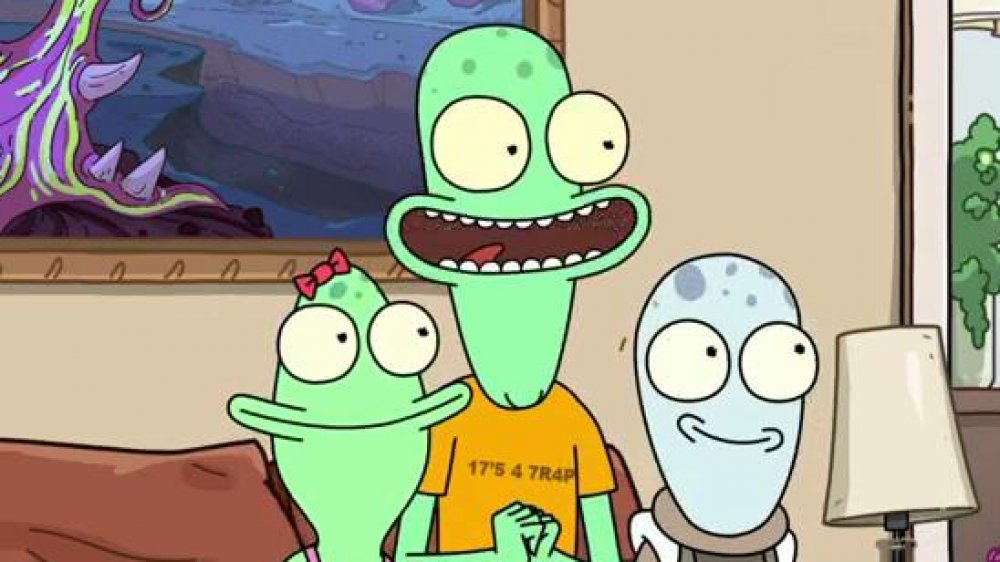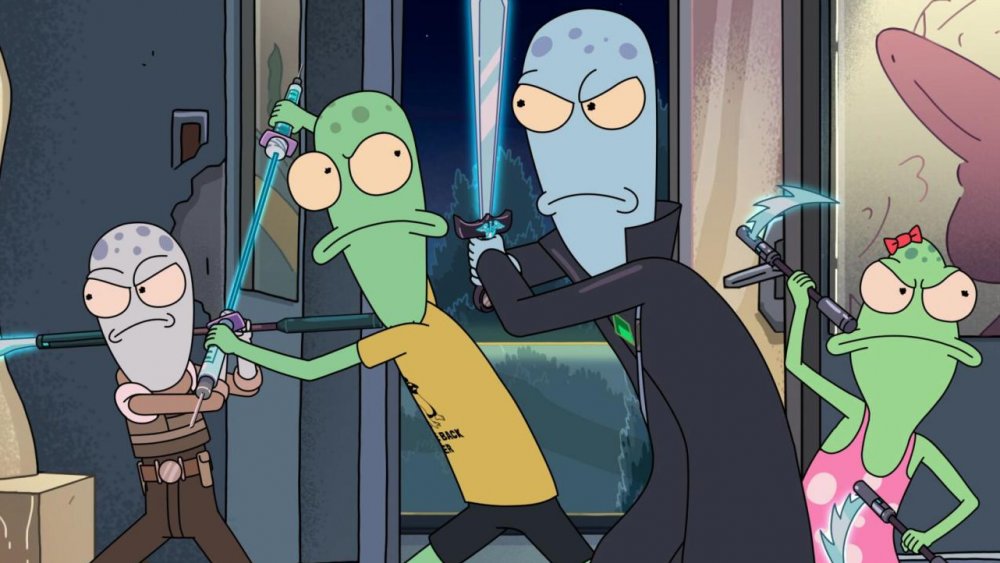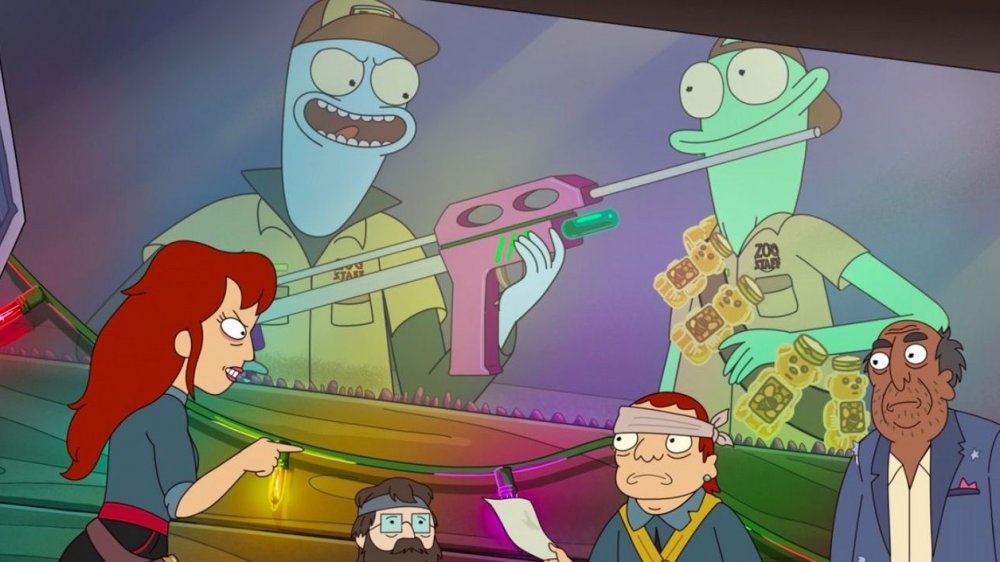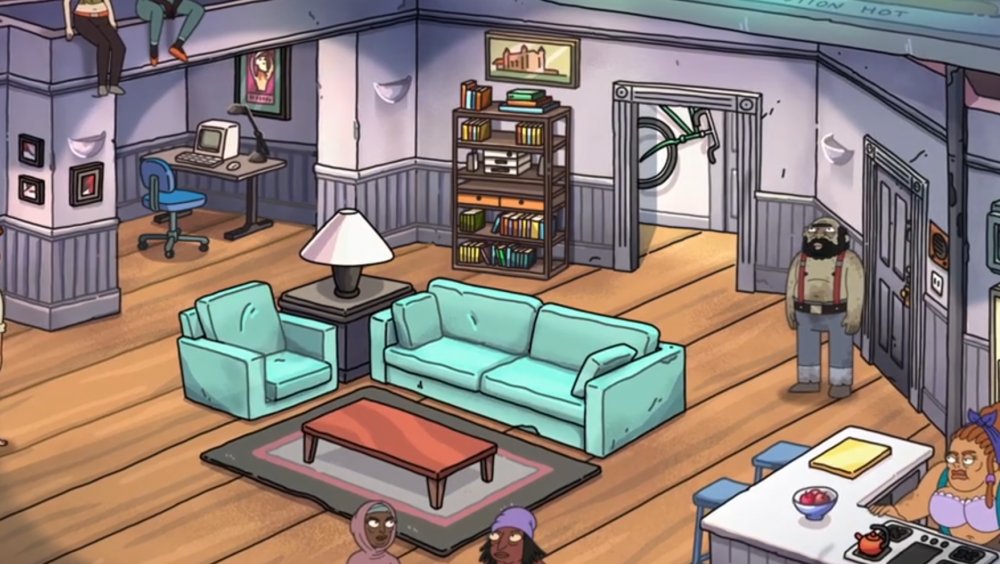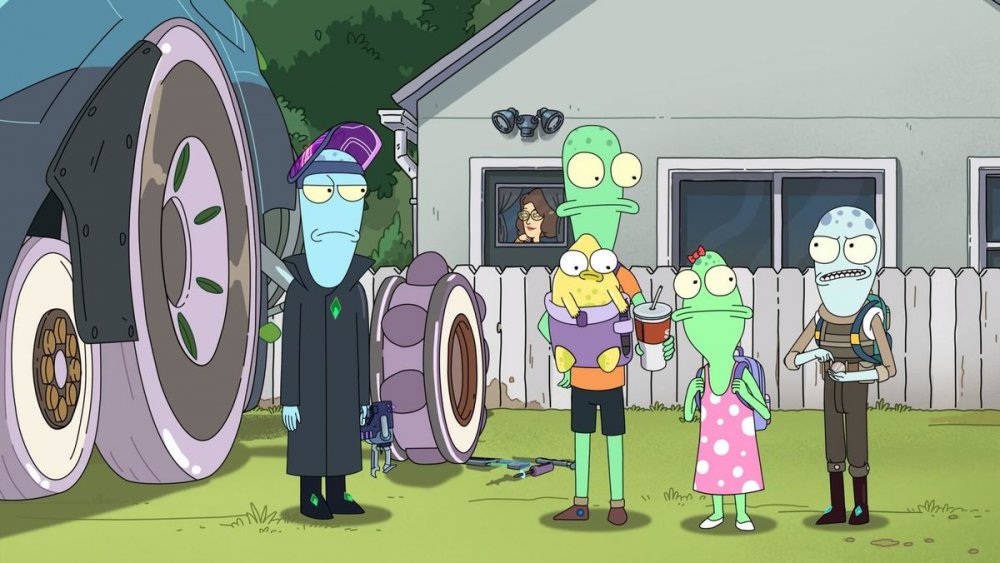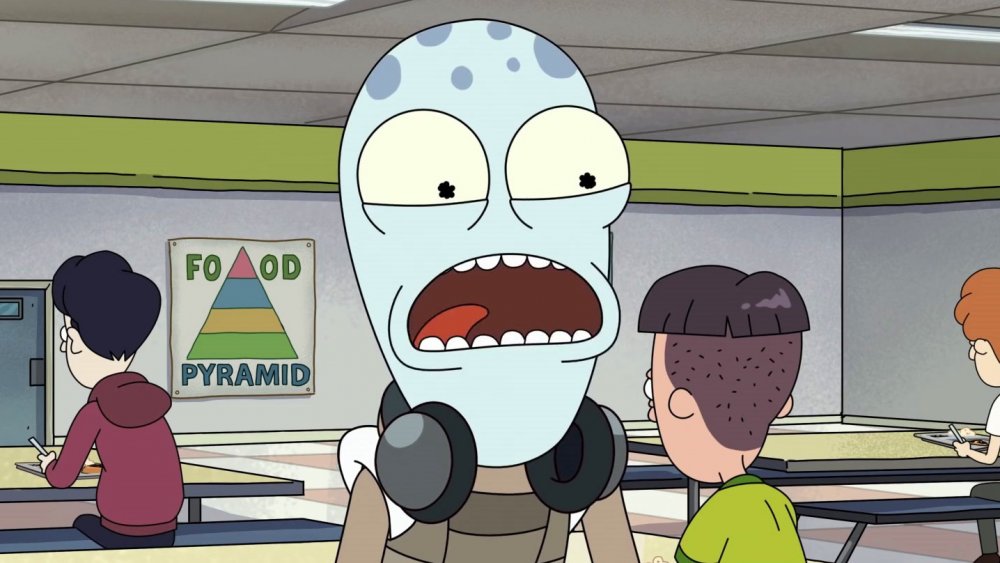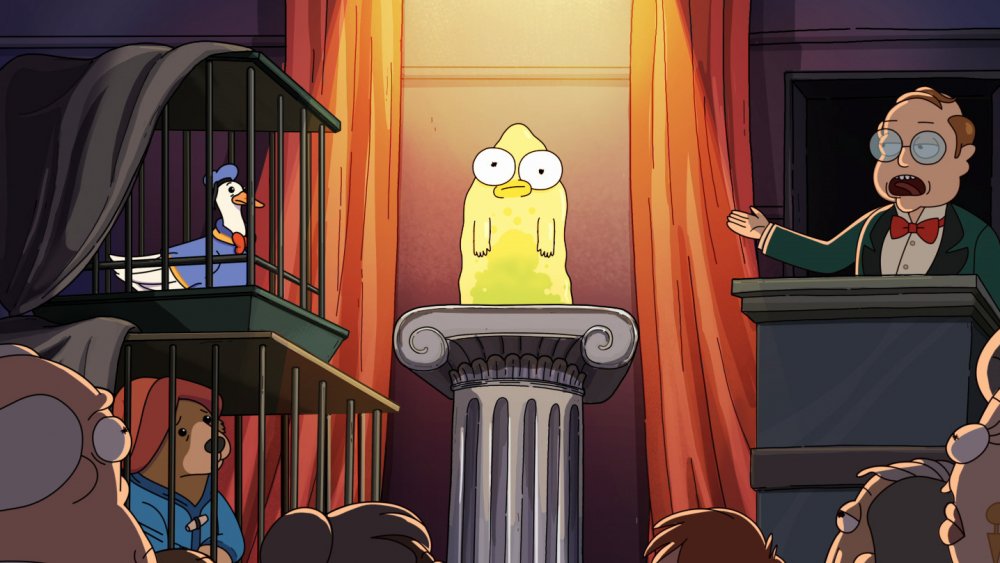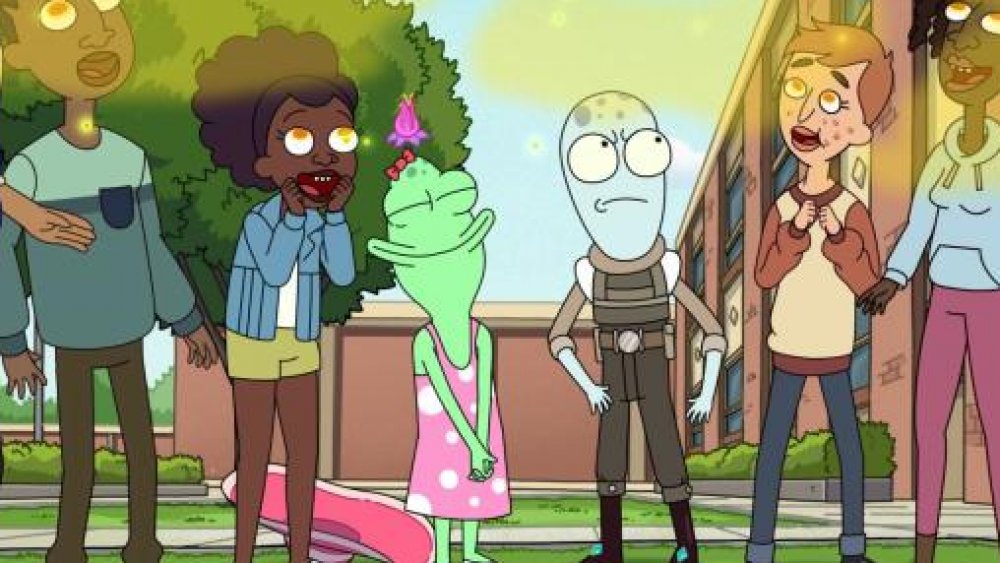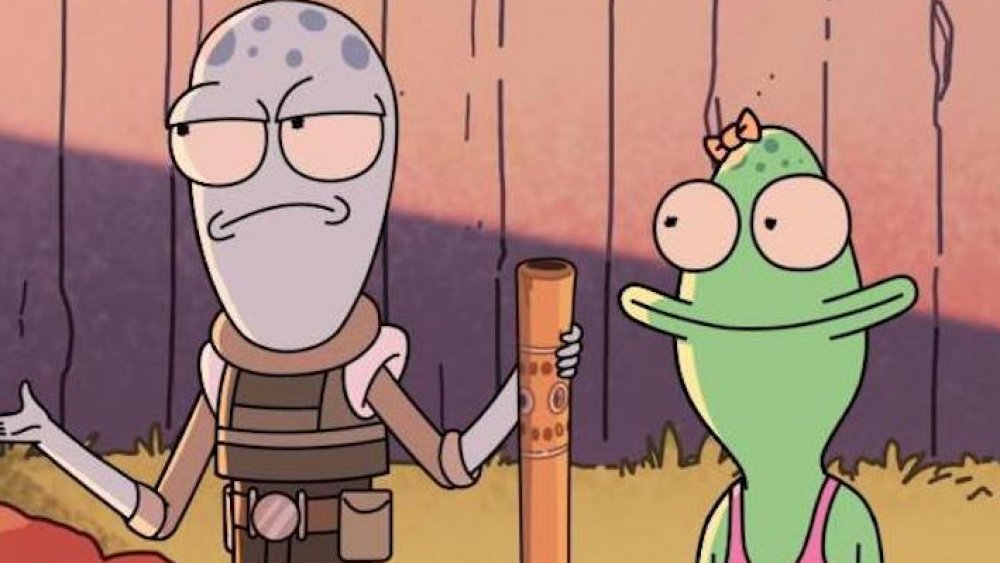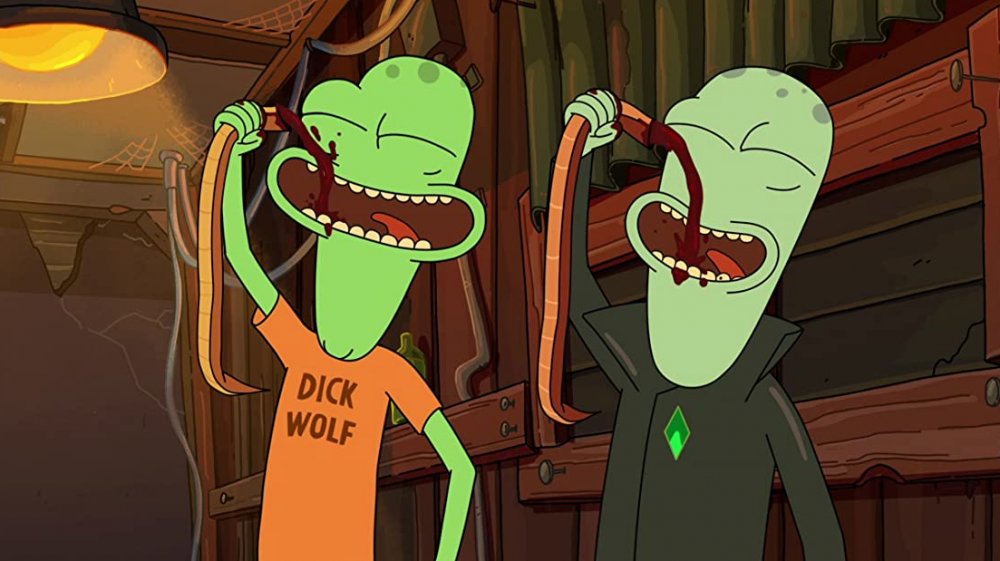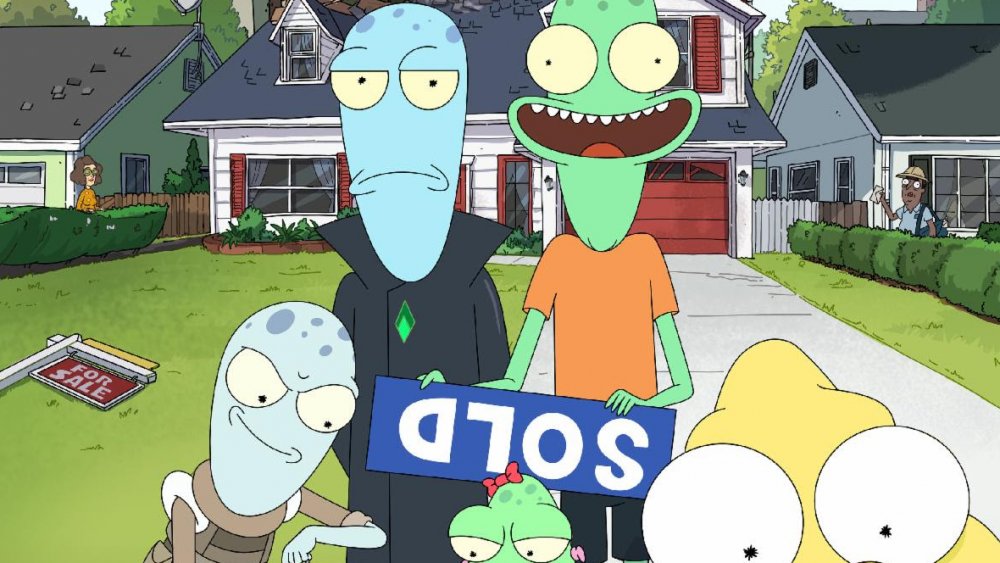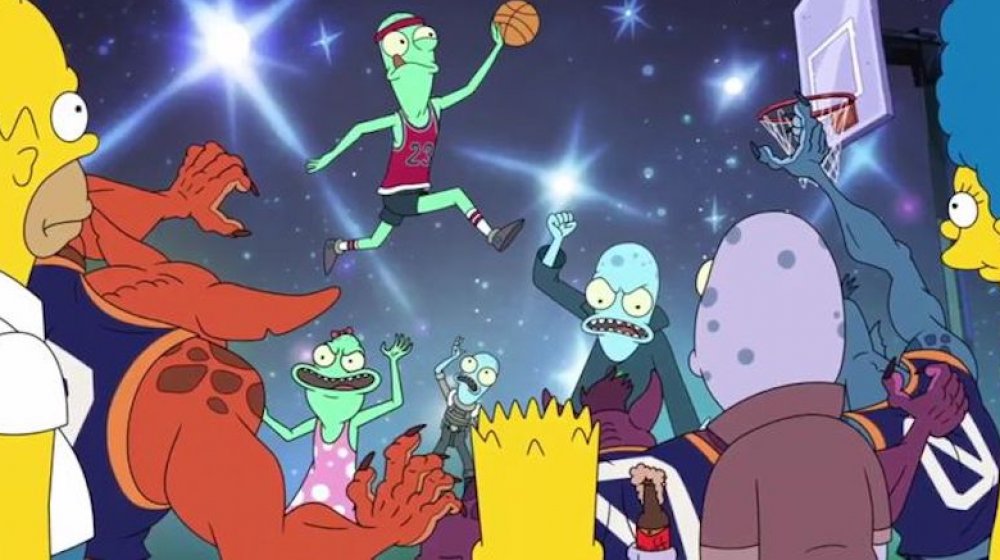The Untold Truth Of Solar Opposites
Justin Roiland and Mike McMahan are the biggest names in animated sci-fi comedy — the former co-created Rick and Morty, and the latter is a longtime writer for the Adult Swim hit. In 2020, the duo took a break from inter-dimensional adventures to launch Hulu's Solar Opposites, about aliens who flee their home planet of Schlorp and crash land in American suburbia.
Not blending in or hiding out like aliens in past TV shows, the Schlorpians wreak havoc and menace upon any Earthling unlucky enough to get in their way. Korvo and his easygoing, Earth-loving partner Terry head up this new kind of family which also includes Korvo's agitated replicant Yumulack and Terry's clone, the sweet and innocent Jesse. And then of course, there's the Pupa, the baby-meets-pet the aliens must protect and raise until it becomes the all-consuming force that will lead to the desecration and terraforming of Earth. You know, just regular sitcom stuff. Whether you're already a viewer or just starting out, here's everything there is to know about those spaced-out aliens from Solar Opposites.
Fox ordered it, and then rejected it
Solar Opposites hit Hulu in May 2020, the end of a journey from public unveiling to consumption that lasted at least five years. In September 2015, Roiland shared key art, character designs, and plot elements on Twitter. Almost all of it wound up in the show, in that it's about a de facto family of four "genderless aliens" named Terry, Korvo, Jesse, and Yumyulak, the latter of which collect shrunken humans, and they all live in a suburban house with their spaceship crashed into the roof. (And don't forget the pupa.)
Solar Opposites, as the show wound up being titled, was first put in development by 20th Century Fox Television to air on the Fox network, home of other animated hits like The Simpsons and Bob's Burgers. However, the network declined to broadcast it, and in 2018 Solar Opposites jumped to Hulu, which gave the show an initial two-season order consisting of eight episodes each. Debuting on a streamer allowed the creators to play up the serialized elements. "That was a big selling point for us when we went to pitch it at Hulu," McMahan told Decider. "It was a big reason to do a show that wasn't like shows we had worked on before. I mean, I've never worked on an animated show with a huge serialized aspect that is all going to get dropped binge-ably on the first day so that people can watch this one long story happening."
How The Wall went Up
The aliens' use of otherworldly technology isn't just joke fodder — it has serious ramifications. "We kept talking about [how] it would be funny if the sci-fi throwaway things [the aliens] did had repercussions," co-creator Mike McMahan told the Los Angeles Times. And thus, as detailed in an epic, standalone, and extremely dramatic episode, "The Wall" was built. Teenage replicant Yumyulack is often in a foul, human-hating mood, and anytime a person wrongs him, he zaps them with his shrink ray and puts them in the massive, multi-level vivarium in his bedroom wall. Inside that wall a brutal, highly-stratified post-apocalyptic society bent on survival at all costs develops, lorded over by the self-proclaimed Duke (Alfred Molina), until he escapes and freedom fighter Tim (Andy Daly) gets corrupted and fills the power vacuum.
"Basically, it was an idea we had really early on, even before we wrote the pilot," co-creator Justin Roiland told CinemaBlend, "to kind of slowly inch our way to a bigger story inside the Wall and treat the Wall like a high-stakes microcosm of society, where it's sort of post-apocalyptic and they have to shed all of their regular-world belief systems and roles." McMahan liked it because he could emulate HBO's The Wire. "You know, The Wire has like the dockworkers on one side and then the regular show on the other," he said. "And I've never seen that in an animated comedy before."
What's the deal with the Seinfeld set?
Tim's band of revolutionaries plan their attack on the Duke in a tiny replica of Jerry Seinfeld's apartment set from Seinfeld, which isn't quite the right scale but offers a working refrigerator and a wacky, Kramer-like neighbor. It's very similar to one owned by show co-creator Justin Roiland. "I bought one of those stupid Seinfeld replica sets that are online," he told CinemaBlend. He figured it would make a good addition to The Wall. "Two thoughts went through my head. One is like, 'That would be really funny, just because it's a real thing and what a deep-cut weird reference.' But then the other thought was, 'If we do this, and these Seinfeld set replicas take off, I could be sitting on a real goldmine here with my sealed Seinfeld set replica.' You know, I haven't opened it yet." Co-creator Mike McMahan confirmed that Roiland really did say all of that out loud in the Solar Opposites writers room.
The production responded to the coronavirus in a creative way
Every episode of Solar Opposites landed on Hulu in May 2020, when most of the U.S. was under local stay-at-home orders to slow the spread of the novel coronavirus. Eerily, the show's fourth episode touches on virus prevention. After Yumyulack and Jesse sprout plant parts out of their heads, they assume it's "a puberty thing," only for Korvo to explain that it's "just fungus you get for not washing your hands." Terry chimes in, "You gotta wash those hands!" Did Solar Opposites "predict" coronavirus, and a nationwide devotion to hand-washing? Probably not. This episode entered production almost a year before the age of the coronavirus began. "It's amazing, in all the animated shows I've worked on, how often it happens," writer Josh Bycel told the Los Angeles Times. "Where there's just a joke about somebody or something and then it ends up being very timely," Bycel added.
The coronavirus did affect production on the show's second season. By the time lockdowns were ordered, only the scripts were near completion. "We were able to send home the animators with computers," Bycel told Bubbleblabber. "It's worked well so far, but I don't know what's gonna happen once we have to send our material to Vancouver to get colored and all that stuff." Still, that makes Solar Opposites one of the first animated shows to be produced in staffers' homes.
The show held a live animated promotional event
As both the creator and member of the main voice casts of both Rick and Morty and Solar Opposites, Justin Roiland is obligated to promote the projects in which he has such a large stake. But in addition to sitting through press junkets and panel talks at comics conventions, he's done something extremely unique: He does live animation presentations. To promote the game Fallout 76 in 2018, Roiland voiced both Rick and Morty as the animated characters played the title live on Twitch.
In May 2020, Hulu sponsored a live animated Q&A session on Twitter, hosted by Kevin Smith. Roiland (who voices Korvo), along with Solar Opposites cast members Thomas Middleditch (Terry), Mary Mack (Jesse), and Sean Giambrone (Yumulack), answered questions as they came in — in character, in real time, and totally improvised. Meanwhile, the basic animation utilized kept pace, making for an innovative animation (and publicity) experiment.
The important purpose of the Pupa
The Pupa is just a baby, but is also the most important character in Solar Opposites. The other aliens are supposed to carefully raise the young creature to maturity, whereupon it will destroy Earth. Of course, once that happens, there's no more Solar Opposites, so until then, the Pupa goes on some wild solo, often silent adventures, such as getting caught up in a trafficking ring that deals in real animals that look like cartoon characters (the Pupa kind of resembles SpongeBob SquarePants). The character was inspired by a childhood favorite of co-creator Mike McMahan. "Growing up, I loved reading Mad magazine, especially the Sergio Aragones' little mini comic strips, like the wordless comic strips in the margin," he told CinemaBlend. "And when we were breaking stories, we wanted the Pupa... to kind of have these nonverbal adventures."
Also informing the character: McMahan trying to make sense of fatherhood. "At the time we were developing the show, my kid was brand new and I had been learning that I like being a dad but that part of being a dad is you both love and fear your kid at all times," McMahan told Inverse. "We wanted the Pupa to be a combination of what I was feeling of being a father but put into this kind of ludicrous sci-fi comedy lens."
The aliens aren't humanoid lifeforms
Aliens are a well-used trope in American television, and Solar Opposites isn't nearly the first comedy series about fish-out-of-water extraterrestrials trying to fit in with a suburban environment. It clearly owes a debt to shows like ALF (mocked with the TV character on the show-within-a-show Funbucket) and 3rd Rock from the Sun. One big difference between Solar Opposites and other alien television series is that this is likely the first show in history, of any genre, in which the main characters are plants.
Koro and Terry are the parental figures, while Yumyulack and Jesse are their respective, still-growing replicants. They're not biologically, traditionally produced offspring. Co-creator Justin Roiland told Decider that his aliens "don't have genitals the way we think of them, they have kind of just a bump where that would be." This is because "they're plant-based, so the way they reproduce is cutting a piece of themselves off and putting it in specially prepared soil and then they basically grow a replicant." That would explain how Yumyulack and Jesse develop flowers out of the top of their heads that distribute brain-altering pollen.
The unlikely casting of the replicants
Giving voice to Yumyulack and Jesse, the two young replicant characters on Solar Opposites: Sean Giambrone and Mary Mack. This project is extremely high-profile, and somewhat unlikely. Giambrone brings a palpable teenage energy to his role as angsty Yumulack because he is a teenager, and Solar Opposites is only his second main cast role on an animated series, following his time on Cartoon Network's Clarence. (He's best known for portraying Adam Goldberg on ABC's live-action The Goldbergs.) Mack is relatively new to voice acting, building on her career as a stand-up comedian with gigs on Aqua Teen Hunger Force, Golan the Insatiable, and Trover Saves the Universe, a video game created by Solar Opposites' own Justin Roiland.
Despite having the chops for the roles, Giambone and Mack both were left perplexed that they actually got the job. "I just threw it out there, thinking, 'oh, nothing will come of this,' on a crappy iPhone," Mack told Afterbuzz TV of her literally phoned-in audition recording. "I listened back and, like, I can't even believe they let this go through because I would've turned it off were I them." Giambrone also admitted that he sent it a terrible, phone-captured voice sample. "They probably said, 'who has the worst recording of all the people who auditioned for this show?' and it's probably you and I," Mack theorized.
It almost wasn't an animated series
The idea of what would become Solar Opposites first struck co-creator Justin Roiland in 2006, when he was making cartoons for Dan Harmon's Channel 101 and doing a lot of voice acting — in other words, long before making and starring on Rick and Morty made him a marquee name in animation. And while cartoons are obviously the medium in which he shines brightest, Solar Opposites almost wasn't an animated series, but rather a weird, effects-laden puppet show. "I was imagining [the project] as a live-action thing with weird papier-mâché heads and CGI eyes and mouths," Roiland told SyFy Wire. There were also some other elements developed early on that did and did not make it into the final product. "They had some sort of supreme leader that they checked in with at the beginning and end," he added, referring to a nixed concept that would've pulled strongly from Mork & Mindy. However, the idea that one of the aliens "loved Earth: pop culture, video games, everything" manifested in the character of Terry, while another "hated Earth and humans and pollution" morphed into Korvo.
Something's different every episode
Modern-day, adult-oriented, animated comedies have a lot more in common than humor that works on multiple levels and often grotesque-looking characters. It's seemingly standard operating procedure that a cartoon show changes up something in its opening credits from episode to episode. For The Simpsons, it's the last shot, where something weird happens with the family's couch, on Futurama it was a changing tagline, and on Bob's Burgers, the business next door to the titular restaurant is always different.
"We wanted something like that just because we're big fans of all that stuff," Solar Opposites co-creator Mike McMahan told Syfy Wire. This show's ever-changing opening bit? At the end of Korvo's expositional monologue, he rants about various grievances he has with Earth. While only eight total could be used, McMahan wrote plenty for voice actor Justin Roiland to use. "I ended up writing like 30 or 40 things for Justin to riff on and every one of them made us laugh." The running bit nearly had another level to it, with a plan to use a different guest voice actor each episode. "It was asking somebody to build a character and know the show, and then asking an audience to bear with that. It just wasn't flowing," McMahan explained.
It's connected to three other pop culture universes
Solar Opposites isn't a spinoff of Rick and Morty, but it's laced with so many references and Easter eggs that the two shows are inexorably connected, meaning they occupy the same fictional "universe." In the first episode of Solar Opposites, there's a poster hanging on the wall at the replicants' school advertising some "schwifty live jazz" — utilizing Rick's catchphrase. And in episode three, there's a brief advertisement for Trover Saves the Universe, a real-life game created by Roiland. The same game showed up on a billboard during a Rick and Morty episode. As the game exists in both worlds, it connects them. Solar Opposites connected itself to two other animated franchises: Looney Tunes and The Simpsons. In the final episode of the first season, Korvo and Terry fondly recall the time their group beat the Monstars in a basketball game — i.e. the evil aliens from Space Jam. Helping them defeat those aliens were the Simpsons, and Homer, Marge, and Bart briefly appear onscreen.
